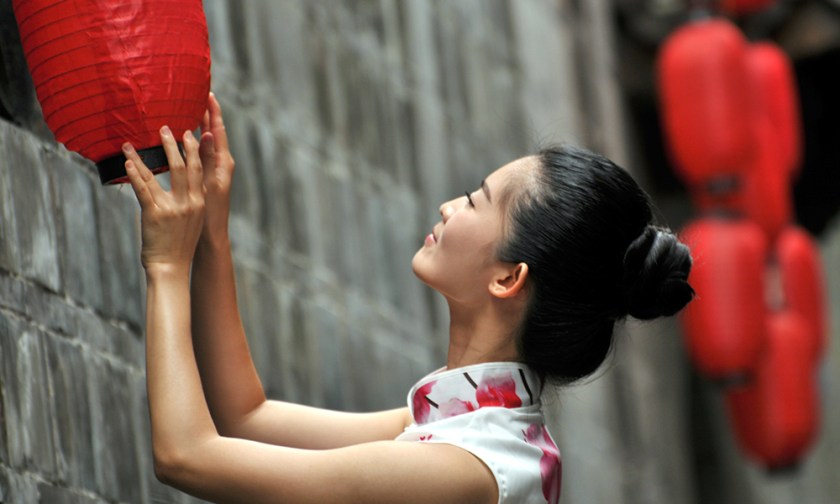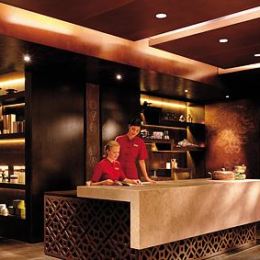In the Chinese lunar calendar, the new year falls on January 28 – so, Happy New Year again, everyone!
For Australians, the internationally-renowned event is a celebration of Chinese, Vietnamese, Thai and Korean cultures. The festivities revolve around family, harmony and wishing good fortune for the months ahead.
Chinese astrology says each year is tied to an animal zodiac sign, combined with one of the five elements. 2017 is marked by the proud rooster; coupled with fire – symbolising warmth, passion and brilliance.
The five elements (wood, fire, earth, metal and water) are important in many aspects of Chinese culture and are a cornerstone of Traditional Chinese Medicine (TCM).
In TCM they are believed to have distinct but related qualities, and human bodies are thought to be biased toward one or two elements in particular, which govern which of our organs are stronger or weaker.
Traditional Chinese Medicine (TCM) is a discipline based on the concept of Qi.
According to the I Ching (an ancient divination text and the oldest of the Chinese classics) Qi is an invisible “life force” that unifies the three energies in the universe – heaven, earth and humans.
For humans, Qi is believed to flow through 12 channels (also known as meridians) in the body, nourishing our organs and, in turn, harmonising the five elements.
Indeed, it is believed that good health hinges on a harmonious flow of Qi, and in ancient Chinese culture, the healing arts work to unblock and cleanse it, where it might be stagnant, or deficient.
TCM has more than 5,000 years of proven history and it’s exceptionally rigorous to be qualified as a practitioner (study can take between 5-10 years).
But it’s only in relatively recent years that Australians have started to embrace TCM as a viable mainstream modality, not just to cure illness and poor health but prevent them from occurring in the first place.
From uber cool cupping (Gywneth Paltrow swears by it) to dietary theory, we celebrate the Chinese healing arts and welcome them to our wellness to-do list.
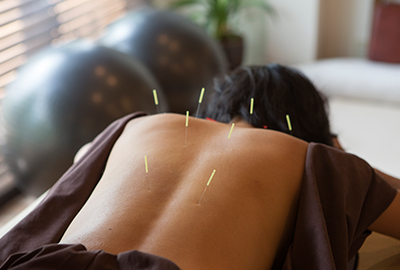
Acupuncture
This is the main modality in TCM used to treat patients – tiny sterilised needles are used to stimulate pressure points along the 12 energy channels in the body.
The holistic healing discipline goes back more than 5,000 years, making it one of the oldest in the world.
It is believed to be effective in treating wide of health issues from serious diseases to hair loss, skin issues and mental health problems such as depression, too.
It is recognised in Australia by the National Registration and Accreditation Scheme for health professionals. One must be registered to the Chinese Medicine Board of Australia to offer services to the public.
“It’s a whole different way of thinking to Western medicine,” says Jinny Koh, a Sydney based TCM practitioner.
“You might have 10 people with the same condition but they’re not all going to be treated with the same pressure points.
“Diagnosis works very differently from modern medicine too. You need to look at a person. Listen to what they’re saying. Look at their tongue and feel their abdomen. Then we ask questions about the function of different parts of the body.
“We take emotional state into account too. Stress relates to the liver. Worry is related to the spleen, fear is related to the kidney, grief is related to the lungs, and joy is related to the heart.”
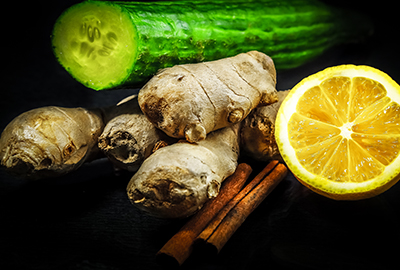
Dietary Theory
TCM practitioners may recommend dietary changes to support other treatments. It is believed certain foods can be help or hinder recovery from illness and general health.
“Diet is very important because we work with the elements, (earth, air, wind, fire) and all the organs are related to one of those elements,” says Maree P. Kearns, Sydney TCM acupuncturist.
“There are certain flavours that strengthen the elements and therefore the organs – all foods have a “quality” to them.
“For example, lemon is sour, the flavour that strengthens or balances the liver, bitter is the flavour that strengthens or balances the heart, sweet is flavour that strengthens or balances the spleen and stomach, pungent foods strengthens or balance the lungs and salt is the flavour that balances or strengthens the kidneys.
“Different foods are recommended for different problems – if someone is hungover, I’d tell them to eat sour plum because that will start to calm the liver down.
“For clients with a spleen imbalance I would recommend food that have a sweet tasting quality. For example, root vegetables like pumpkin and sweet potato. Also, brown rice.
“The method of cooking can make it more suitable to an individual’s constitution. Our body changes according to the season, so in winter it is better to bake food, whereas you can cook more lightly in Spring.”
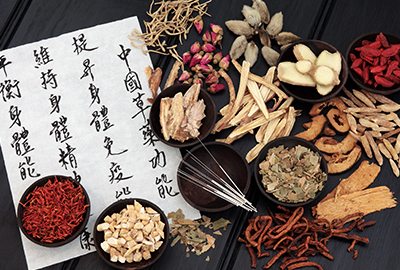
Herbal Remedies
In TCM theory, herbs aren’t just regular spices from the kitchen cupboard – they can include animal parts, minerals, insects, fungi and, of course, plants.
Aficionados believe they not only boost the immune system but aid in healing a plethora of illnesses from digestive disorders to allergies. Like most TCM healing tactics, herbs are prescribed to encourage Qi to flow freely by purging toxins and clearing blockages.
Similarly to food, herbs are classified as either pungent, sour, sweet, salty, bitter or bland. And, like food, they can have cooling or warming properties.
They’re prescribed in singular form or can be combined. Formulas are tweaked to the specific constitution and condition of the patient while taking into account the individual therapeutic actions of each herb (as well as the effects when combined together) – actions include tonifying, harmonising and softening.
“Stress might cause excess heat in the liver so the patient might require a neutral (rather than warming or cooling) remedy from a “sweet” tasting herb to calm it down,” says Jinny Koh.
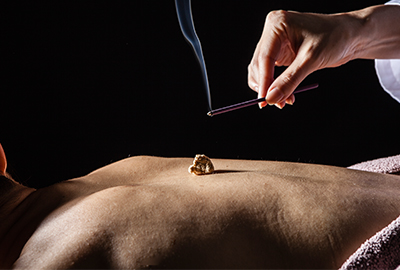
Moxibustion
This is a traditional TCM technique that involves the burning of mugwort, a small, spongy herb, to facilitate healing.
It has been used in Asia for thousands of years and is believed to strengthen the blood, stimulate the flow of Qi, and maintain general health.
The specialist places a small, cone shape amount of the mugwort atop a chosen pressure point on the body (usually on the back), then burns the herb.
David Suh, practitioner and senior lecturer at Sydney Institute of Traditional Chinese Medicine, offers moxibustion at his clinic located in Chatswood, Sydney.
“I extinguish it, and remove the herb before it burns the skin. It doesn’t hurt, but the patient will feel a pleasant heating sensation.” he says.
“As the mugwort is burning, the chemical produced stimulates Qi, and it’s it works to remedy ailments associated with a “cold” constitution, one that is biased toward the cooler elements of water or metal.
“I’ve found it very useful in patients with poor digestion, or digestion issues in general.”
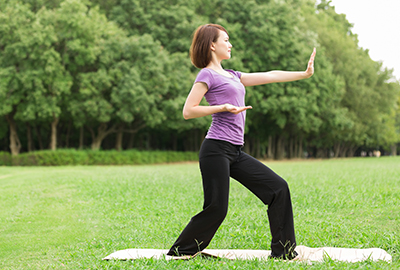
Tai Chi
The ancient Chinese martial art of Tai Chi is practised world wide for its health benefits. It is characterised by slow, intentional movements, mindful breathing, awareness exercises and meditation.
Kellen Chia, the principle of the Tai Chi Society in Sydney has progressed through the ranks and is now a Great Great Grand Master, the highest grade of teacher.
“It is a healing art that improves the flow of Qi or life energy in the body,” he explains.
“When the energy flows through the body without blockages or stagnation, it means a happy mind, happy body and happy spirit.
“Tai Chi encourages the movement of Qi and can make you feel healthy and energised. It is excellent for alleviating headaches and is believed to help the symptoms of arthritis, asthma, diabetes and even Parkinson’s disease.
“Virtually anyone, regardless of age or mobility can take up Tai Chi in a beginners group and enjoy it.”

Tui Na Massage
This ancient Chinese healing technique is a form of “hands-on” remedial massage that involves brushing, kneading, rolling and pressing the soft tissue between the joints to release blockages of energy and regulate the flow of Qi.
It is believed to be helpful in relieving chronic pain from in the shoulders and neck from injuries but can also be useful alleviating stress related disorders such as insomnia
Maree P. Kearns sometimes incorporates the technique into her acupuncture treatments.
“You can feel where the Qi is blocked with your hands, and you can also see it with your eyes,” she explains.
“The blockage sometimes looks like a swelling, or the body might look more rounded in that area. And it can also take shape as a hollow where the quality of the skin appears different.
“Sometimes the site of pain is right where the block of Qi is, but pain may manifest up and down the channel away from the block.”

Cupping
Despite the unsightly red (sometimes black) marks that are synonymous with cupping, celebrities such as Gwyneth Paltrow, Jennifer Aniston and Victoria Beckham swear by it for vitality and wellbeing.
In TCM, however, this therapy tends to be harnessed for respiratory diseases or musculoskeletal ailments, rather than general health.
Glass or bamboo cups are applied to soft areas on the back, shoulders or the thighs. They create a vacuum of sorts by suctioning out the air.
The vacuum effect is believed to open up the channels and allow Qi to flow freely. Toxins are released which facilitate deep tissue healing.
The suction pressure pulls tissue upwards which tends to “pinch” for a few seconds, then feel soothing.
“The cups release obstructions to the flow of Qi, it works to release pain by moving the energy and the blood.” explains Maree P. Kearns.
“Rather than putting the cup exactly where the pain is, the practitioner will look at your back and decide where to put the cup according to a number of different factors.
“When used to treat a chest condition, cups will usually be splayed over the back because the lungs take up a lot of that area.”

